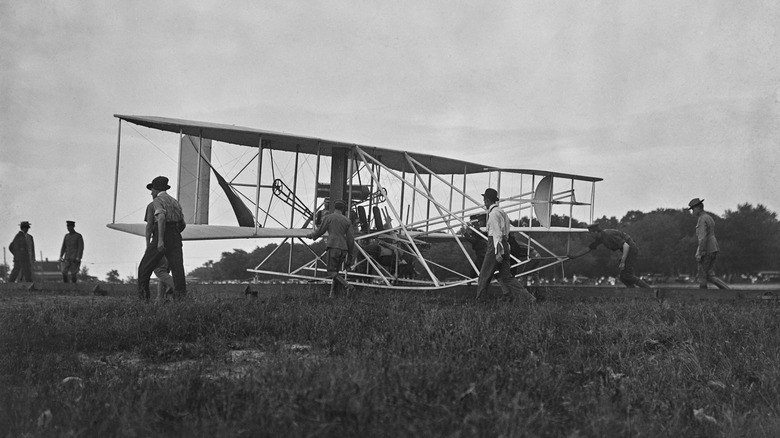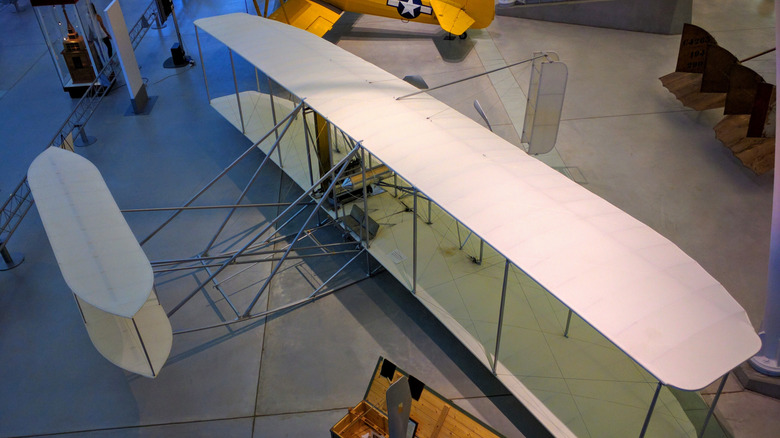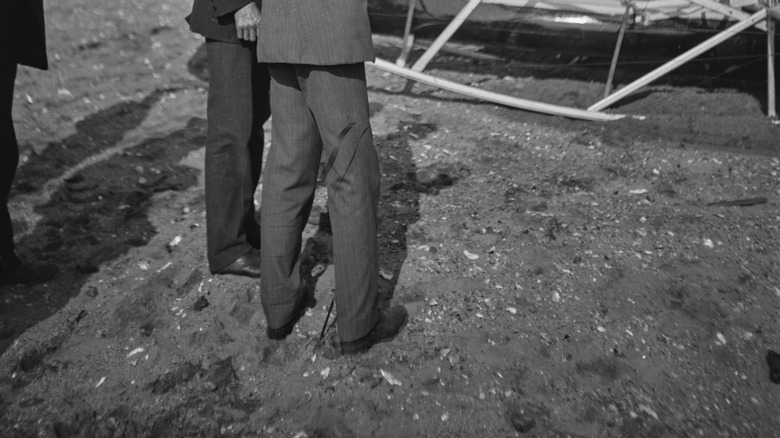What Was The First Military Plane And How Much Did The Army Pay For It?
What's the most iconic airplane in history? Some might say it's the unmistakable pointy-nosed speedster Concorde, or perhaps the World War II superstar that was the innovative Supermarine Spitfire. Such models have had an incredible influence on the course of aviation, and, like the Wright Brothers' Wright Flyer, cannot be forgotten for the role they played. The latter, which took to the air in December 1903, holds the Guinness World Records accolade for the first powered flight. Wilbur and Orville Wright, history makers that they were, certainly weren't about to stop there.
The Wright Military Flyer that followed isn't as famous as its fellow Wright machine, but it too made history: It was the first model ever built as a military aircraft specifically. This isn't to say that it was heavily armed like some of today's military jets, of course, with the likes of Meteor and Sidewinder missiles still decades away (as were jet engines themselves, in fact). This was far from the role that the military had in mind for it, though.
Reliable and sustained flight has enormous implications for reconnaissance, which has always been a primary military concern. Watching the success of the first Wright Flyer was surely a lightbulb moment for the U.S. Army, which would go on to purchase the aircraft from the brothers for $30,000 in the Summer of 1909. National Air and Space Museum curator Peter Jakab notes that this was "an enormous sum in those days," and not one without significant caveats attached.
The purchase and purpose of the Wright Military Flyer
The army laid out quite ambitious requirements for the aircraft they were seeking. A range of at least 125 miles and a speed of 40 mph, on top of a flight time of one hour, were targets as lofty as the final $30,000 price tag (which was originally $25,000) by the standards of the time. Nonetheless, the Wrights accepted the challenge. The aircraft they designed to meet it was just short of 29 feet long, with a wingspan of 35 feet and six inches. Powering the majestic machine was an engine with an output of 32 hp. Staggeringly low horsepower doesn't mean that an aircraft can't fly, though.
Needless to say, the Wright brothers then had to engage in some high-profile flight demonstrations to prove that their aircraft could do what it needed to. In late July 1909, before such distinguished attendees as then-President Taft himself, the Wright Military Flyer embarked on a series of flights, one of just over 12.5 minutes above the one-hour requirement, and another that would achieve a pace slightly above the 40 mph specified. With that, this unique aircraft was added to the ranks of the Signal Corps.
Today, the U.S. Air Force has no shortage of past and current veteran pilots. At the time the army bought the Wright Military Flyer, though, there really were no aviation experts with the practical experience that the brothers had. This new aircraft, then, was used to train those budding pilots.
The fate of the Wright Military Flyer
The Wrights' military aircraft was officially designated Signal Corps Airplane No. 1. Now, a military aircraft isn't necessarily going to see military action. Today, there are a huge range of supportive air force, army, and naval vessels that don't take part in combat, either directly or indirectly. It was designed as an unarmed recon plane, but the Wright Military Flyer was never officially used during combat.
It may or may not have been the ultimate intention for it to do so, but as it was, the machine found a vital use as a training aircraft, with the brothers starting to instruct the first potential pilots later that year. Signal Corps Airplane No. 1 wouldn't serve for very long, being withdrawn early in 1911, but it's hard to quantify its importance in military history. Over a full century of air force technology has evolved since the Wright Military Flyer's debut, in the United States and around the world. Aviation history may have looked very different without this model and the lessons learned from it. $30,000 very well spent indeed, all told.


